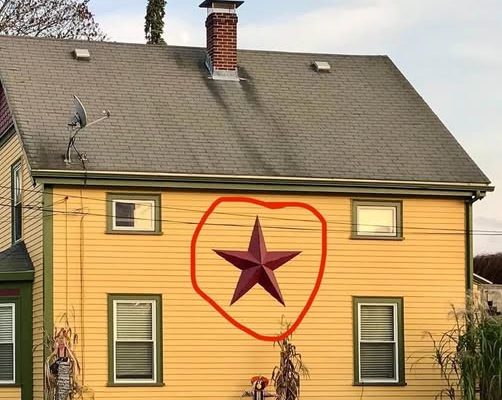A charming ornament frequently seen adorning the upper part of barn doors is the barn star. These stars can be either painted directly onto the surface or crafted from metal. Occasionally, they are substituted with hex signs or quilt blocks.
The presence of these decorations serves a significant purpose, which may not align with common assumptions. German-American farmers attribute great importance to barn stars, placing them atop barns to ward off misfortune or to promote the healthy growth of crops.
Notably, each barn star can vary in color, with each hue conveying a distinct meaning. For instance, a green barn star signifies the promise of fertile crops, while blue or black stars indicate the safety of the farmer, their family, and their possessions. In contrast, a brown star symbolizes friendship.
The origins of barn stars are quite fascinating. The first barn star was placed on a barn in the 1830s, and they have since gained popularity. Each design represents an adaptation of German folk art that was brought to America.
The Amish community, known for its commitment to simplicity and a lifestyle free from modern technology and popular culture, has preserved the tradition of barn stars among other customs passed down through generations.
Moreover, for individuals with deep connections to Pennsylvania Dutch heritage, the meanings associated with these symbols can vary significantly. Patrick Donmoyer emphasizes the importance of recognizing the coexistence of two distinct practices: “There are the barn stars and then there are the hex signs.”
Barn Stars May Provide Protection
Donmoyer oversees the Pennsylvania German Cultural Heritage Center at Kutztown University. He noted that numerous hex signs appeared in various contexts, such as on marriage licenses, to bestow good fortune upon newlyweds, or on grave markers to assist the deceased in finding tranquility in the afterlife.
Superstitions have existed for millennia, evolving over time to align with the changing desires of a dynamic global population.
Interestingly, barn stars did not possess the “power” or significance that many people currently attribute to them. Donmoyer asserts, “These were integral to the agricultural lifestyle.” They were not necessarily associated with supernatural beliefs or occurrences.
It is important to note that hex signs originated on barns nearly a century after the emergence of barn stars.
Hex Signs Are Distinct
In 1924, Wallace Nutting, an artist from New England, visited Pennsylvania Dutch Country and “misinterpreted” the original quilt squares or barn stars, leading to the creation of hex signs. Donmoyer remarked, “He was discussing something tangible, but what he described was incomplete.”
Nutting was not referring to the stars on the barns; rather, he was addressing the concept of hexenfoos, rearranging the elements of the tradition.
By the 1950s, these designs underwent further modifications and became a popular attraction for tourists.
Barn stars and quilt squares adorning barns throughout Pennsylvania Dutch Country symbolize the creativity, diligence, and customs of a culture that has often perplexed outsiders. These symbols reflect inherited cultural and familial traditions.
Thus, while many believe barn stars ward off malevolent forces, the Pennsylvania Dutch utilized them to honor their ancestors and their heritage.
Barn Stars May Provide Protection
Donmoyer oversees the Pennsylvania German Cultural Heritage Center at Kutztown University.
He noted that numerous hex signs have appeared in various contexts, such as on marriage licenses, intended to bestow good fortune upon newlyweds, or on grave markers to assist the deceased in finding tranquility in the afterlife.
Similar beliefs exist across many cultures. As previously mentioned, superstitions have persisted throughout history.
Individuals often hold the belief that these symbols can ward off malevolent forces, prevent negative karma, and frequently attract prosperity and joy.
It is not surprising that numerous tribes and nations possess their own ancient symbols, which have evolved to safeguard homes and families from harm, such as barn stars.
The Om or Aum symbol in Hinduism and Buddhism serves as an example. This symbol is frequently employed to protect individuals during meditation and other spiritual practices.
While many are familiar with the sound of the word, it also conveys a visual representation. It is believed to “purify” the mind and body, fostering a harmonious balance between tranquility and life’s challenges.
The Eye of Horus, a prominent symbol in Egypt, exemplifies another protective emblem. This powerful symbol, often found in Egyptian art or jewelry, is thought to possess healing and protective qualities.
Additionally, the Hamsa Hand, prevalent in the Mediterranean and Middle Eastern cultures, is believed to repel negativity while promoting health, wealth, and good fortune.
Turtle
The “Let It Stand” totem pole featuring turtle carvings is located at the East Gate of Algonquin Park in Ontario, Canada, as of November 4, 2018.
Turtles are also regarded as a significant symbol, which I find particularly intriguing.
In Native American and African cultures, the turtle represents longevity, wisdom, fertility, and a deep connection to the earth.
Helm of Awe.
The Hood of Fear, also known as the Hood of Awe, is a contemporary Icelandic magical emblem that shares its name with a concept from Norse mythology.
Additionally, the Norse symbol referred to as the Helm of Awe is believed to offer protection to warriors during combat and instill fear in their adversaries.
Despite the barriers that have historically existed between nations, technological advancements have facilitated a greater understanding of the similarities among various countries and cultures.
Each of these symbols possesses its unique designation and significance.
Nevertheless, every emblem is regarded as a beacon of safety, prosperity, and well-being, serving as a reminder of the aspirations our ancestors held for their families and communities in the future.




